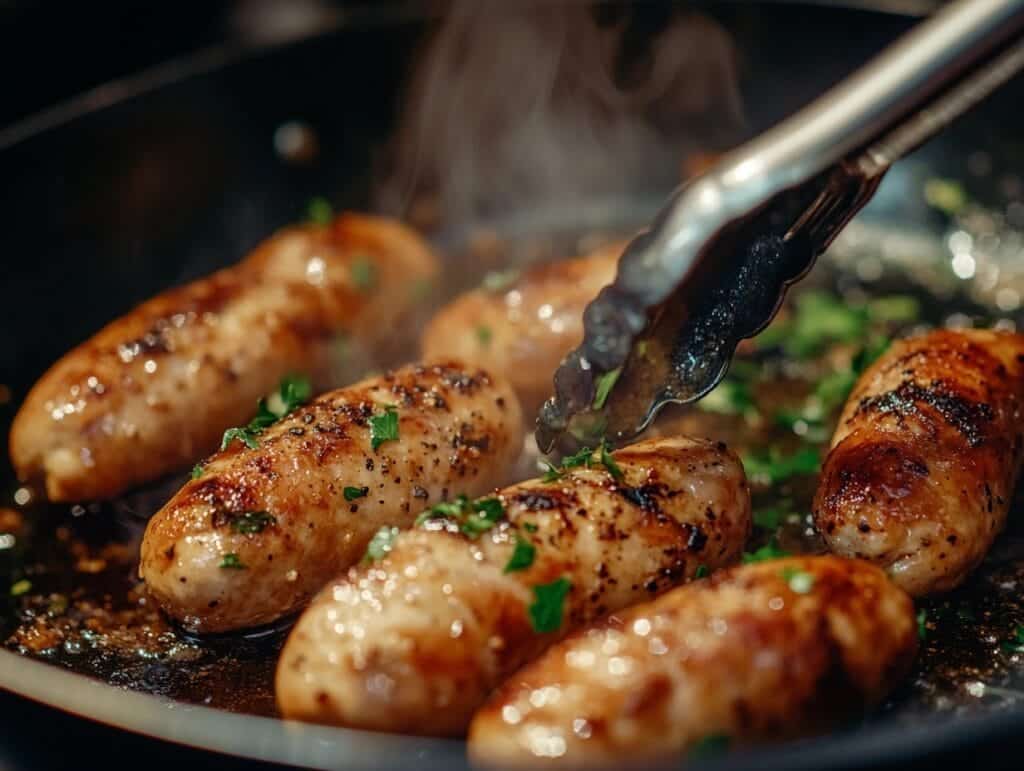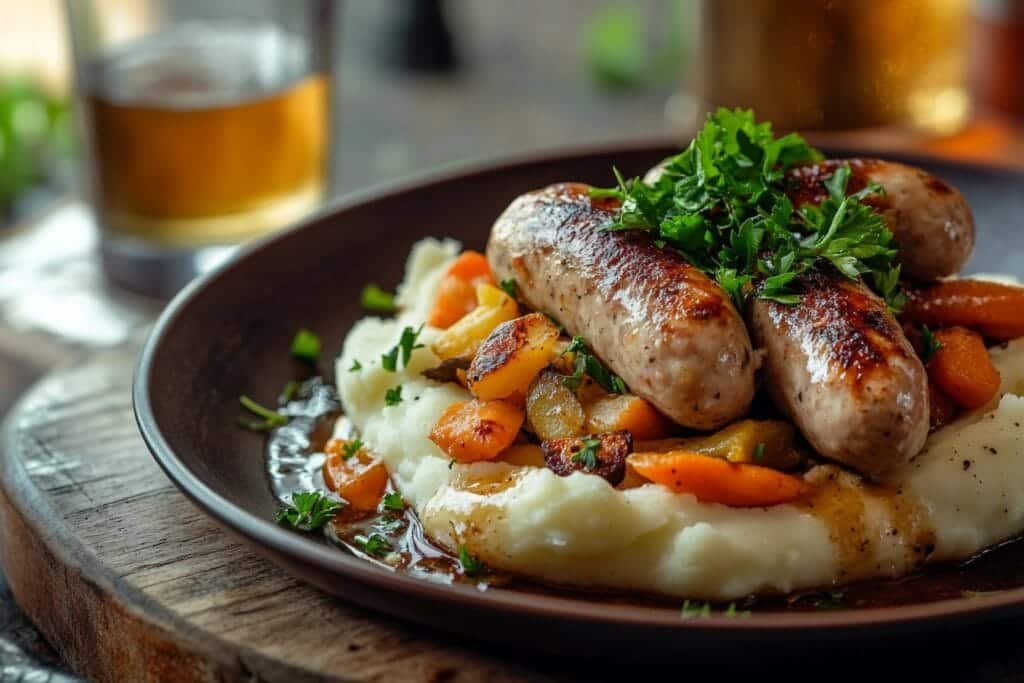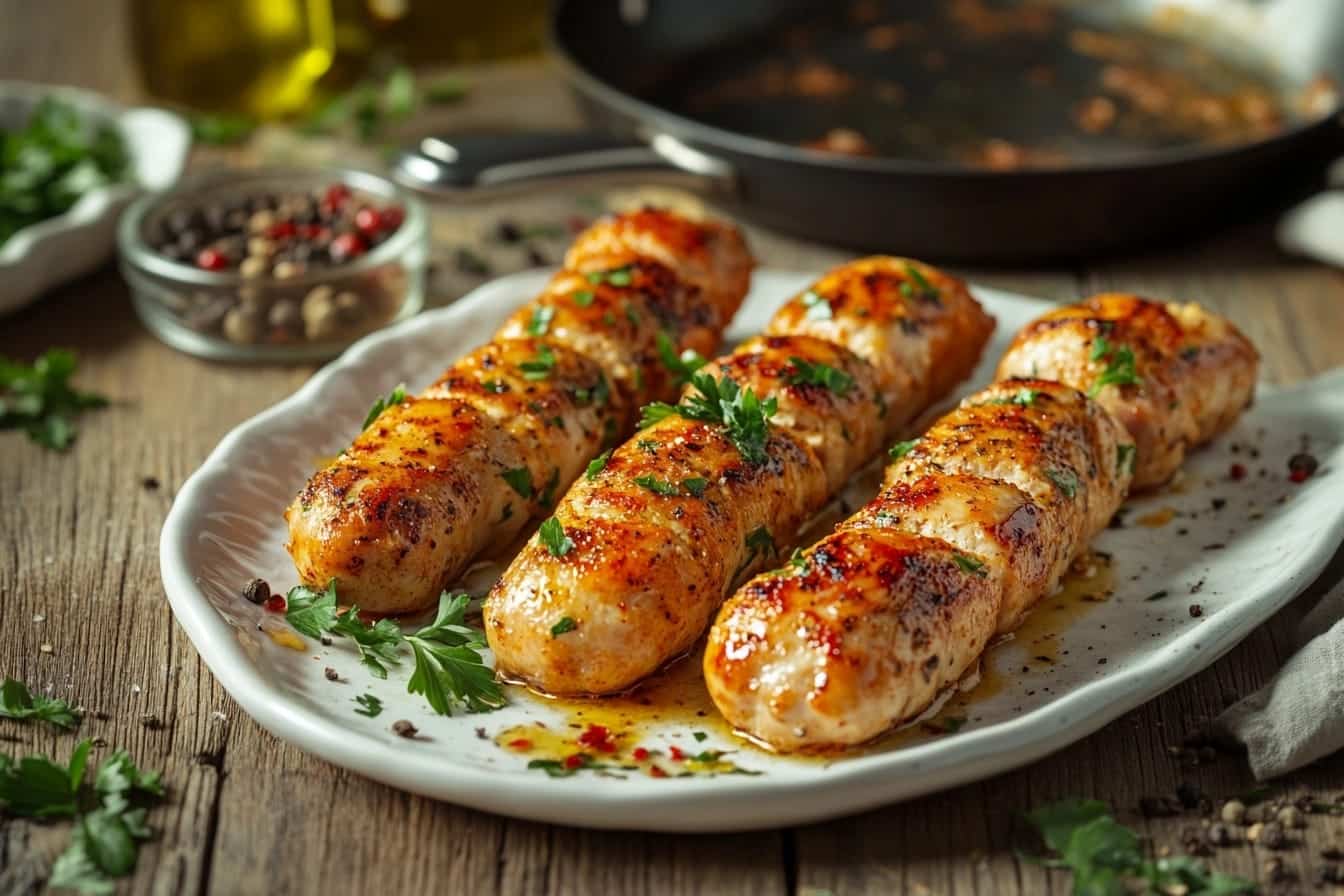Pan frying chicken sausage is one of the simplest ways to cook this versatile ingredient to perfection. Whether you’re preparing breakfast, lunch, or dinner, this method guarantees juicy, flavorful results with just a few basic steps. In this guide, we’ll cover everything from choosing the right chicken sausage to serving it with a side dish that suits your taste. Follow along to master this easy cooking method, avoid common pitfalls, and make your next meal unforgettable.
Understanding Chicken Sausage
What Is Chicken Sausage?
Chicken sausage is a flavorful alternative to traditional pork sausage, made primarily with ground chicken and a blend of herbs and spices. It often comes in various flavors, from mild Italian to spicy Cajun. Packed with protein and lower in fat, it’s a popular choice for those looking for a healthier sausage option.
Nutritional Benefits of Chicken Sausage
Chicken sausage is a leaner alternative to traditional options, offering high protein and essential nutrients like phosphorus and B vitamins. For more detailed insights into the nutritional value of chicken and its health benefits, visit Healthline.
Popular Varieties and Flavors
From apple-infused chicken sausage to garlic and herb options, there’s no shortage of choices in the market. You’ll also find gluten-free, nitrate-free, and organic options, catering to a wide range of dietary preferences.
If you’re looking for a step-by-step guide to mastering the art of pan-frying chicken and achieving crispy perfection every time, check out The Ultimate Guide to Pan-Fried Chicken. This resource dives deeper into tips and techniques for perfecting your pan-frying skills.
Selecting the Right Chicken Sausage
Fresh vs. Pre-Cooked Sausages
When deciding between fresh and pre-cooked chicken sausages, it’s all about convenience and flavor preferences. Fresh sausages require more time to cook but often have a richer, homemade taste. On the other hand, pre-cooked sausages are a time-saver, as they only need to be reheated and browned. If you’re looking for a quick meal, pre-cooked options might suit you best. For those who value control over seasoning and texture, fresh sausages are the way to go.
Choosing Quality Brands and Ingredients
Not all chicken sausages are created equal. Look for brands that prioritize natural ingredients and avoid additives like nitrates and artificial flavorings. Reading labels can help you find sausages with lower sodium levels and no fillers. Opt for organic or locally sourced options when available—they often taste fresher and are more sustainable choices.
Necessary Equipment and Tools
Choosing the Appropriate Pan
A good-quality pan can make or break your sausage-cooking experience. Non-stick pans are ideal because they prevent sticking and require less oil, making cleanup easier. If you’re after a crispier texture, consider a cast-iron skillet, which distributes heat evenly and locks in flavor. Avoid using lightweight pans that heat unevenly—they can lead to burnt exteriors and undercooked centers.
Essential Utensils for Pan Frying
A pair of heat-resistant tongs is indispensable for flipping sausages without piercing their casings. A meat thermometer ensures the sausages reach a safe internal temperature of 165°F. Additionally, keep a splatter screen handy to minimize mess and protect yourself from hot oil.
Preparing the Sausage for Cooking: Tips for Skillet Sausage Cooking
Thawing Frozen Sausages Safely for Sautéing Chicken Sausage
If your sausages are frozen, it’s essential to thaw them properly to ensure even cooking when frying chicken sausage or preparing pan-cooked sausage dishes. The best method is placing the frozen sausages in the refrigerator overnight. This slow thawing process keeps them at a safe temperature, reducing the risk of bacterial growth.
For faster results, seal the sausages in a leak-proof plastic bag and submerge them in a bowl of cold water. Change the water every 30 minutes to maintain a cold environment. Avoid thawing at room temperature or using hot water, as this can lead to uneven thawing and potential spoilage. Properly thawed sausages will cook more evenly, making your skillet sausage cooking easier and tastier.
Pricking or Not Pricking the Sausage Casings When Frying Chicken Sausage
A common question when cooking chicken sausage recipes is whether or not to prick the casings. Some believe pricking helps release excess fat, while others argue it results in dry, less flavorful sausages. For chicken sausages, which are naturally leaner, it’s generally better to leave the casings intact to retain their natural juices.
If splattering is a concern during skillet sausage cooking, control the heat by using medium heat and flipping the sausages regularly. This prevents bursting without losing flavor or moisture. For best results, let the sausage cook in its casing to keep it juicy and tender—perfect for frying chicken sausage or sautéing it with vegetables and other ingredients.

Step-by-Step Guide to Pan Frying Chicken Sausage
Pan frying chicken sausage doesn’t have to be complicated. With the right technique, you can achieve sausages that are golden brown on the outside and juicy on the inside. Follow these steps to cook them to perfection.
Heating the Pan Correctly
Begin by heating your pan over medium heat. Preheating ensures that the sausages cook evenly without sticking. Avoid starting with a cold pan, as this can lead to uneven browning. Allow the pan to heat for 2–3 minutes before adding oil or butter.
Adding Oil or Butter: Which Is Better?
Both oil and butter work well, but the choice depends on your flavor preferences. Use neutral oils like canola or vegetable oil for a clean taste, or olive oil for a mild, fruity flavor. Butter adds richness, but be mindful—it can burn at high temperatures. A combination of oil and butter is often a great compromise, offering both flavor and higher heat tolerance.
| Ingredient | Pros | Cons |
|---|---|---|
| Neutral Oil | High smoke point, clean flavor | Minimal added flavor |
| Olive Oil | Healthy fats, mild taste | Lower smoke point |
| Butter | Rich flavor | Can burn at high temperatures |
| Oil + Butter Mix | Balanced flavor and heat tolerance | Requires monitoring |
Placing the Sausages in the Pan
Once the pan and oil are ready, gently place the sausages into the pan, spacing them evenly. Avoid overcrowding the pan, as this can cause the sausages to steam instead of fry. Leave some room to maneuver the sausages with your tongs.
Monitoring Cooking Time and Temperature
Cook sausages over medium heat for the best results. Too high, and you risk burning the outside while leaving the inside raw. For fresh sausages, cook for about 12–15 minutes, while pre-cooked sausages take 8–10 minutes to brown and heat through. Use a meat thermometer to ensure they reach the safe internal temperature of 165°F.
Turning the Sausages for Even Browning
Turn the sausages regularly using tongs to brown all sides evenly. Every 2–3 minutes, rotate the sausages gently, ensuring they cook uniformly. If some sides cook faster, adjust the placement in the pan for better heat distribution.
Ensuring Sausages Are Fully Cooked
To verify doneness, slice into one sausage to check for clear juices and no pink center. Alternatively, use a meat thermometer for accuracy. Insert it into the thickest part of the sausage, aiming for 165°F. Once fully cooked, remove the sausages from the pan and let them rest for 2–3 minutes before serving. This resting time allows the juices to redistribute, making each bite tender and flavorful.

Common Mistakes to Avoid
While pan frying chicken sausage is straightforward, a few common missteps can lead to uneven cooking or a less-than-ideal result. By steering clear of these pitfalls, you’ll ensure perfectly cooked sausages every time.
Overcrowding the Pan
One of the biggest mistakes is trying to cook too many sausages at once. When the pan is overcrowded, the sausages steam instead of fry, leading to soggy textures and uneven browning. Always leave enough space between sausages for heat to circulate properly. If you’re cooking a large batch, do it in multiple rounds to maintain consistent quality.
Using Insufficient Oil
Adding too little oil or skipping it altogether can result in sausages sticking to the pan and tearing their casings. A small amount of oil, about a tablespoon, is enough to prevent sticking and promote even browning. Remember to adjust the oil quantity based on the type of pan—non-stick pans need less oil, while cast-iron skillets may require more.
Cooking at Incorrect Temperatures
Temperature control is key to success. Cooking at a high temperature may char the exterior before the sausage is fully cooked, while a low temperature can lead to dry, rubbery sausages. Stick to medium heat for the best results. A properly heated pan allows the sausages to cook evenly, locking in juices without burning.
By avoiding these common mistakes, you’ll enjoy flavorful, well-cooked chicken sausages every time you pan fry.
Seasoning and Marinades
Seasoning and marinades can elevate the flavor of chicken sausages, turning a simple dish into something unforgettable. Whether you season them before cooking or enhance the flavor afterward, these tips will help you create a dish tailored to your taste.
Pre-Cooking Seasoning Options
For fresh chicken sausages, applying a light seasoning before cooking can add depth to their flavor. Consider using a dry rub made of garlic powder, smoked paprika, and a pinch of black pepper. If you prefer a tangy taste, marinate the sausages in a mixture of olive oil, lemon juice, and chopped rosemary for 30 minutes before cooking. For a spicier kick, blend cayenne pepper with a touch of cumin and coat the sausages lightly.
Remember not to over-season pre-cooked sausages, as they often come pre-flavored. A simple sprinkle of fresh herbs like thyme or parsley can complement their existing flavor without overpowering it.
Post-Cooking Flavor Enhancements
Once your chicken sausages are perfectly pan-fried, there are endless ways to enhance their flavor. Drizzle them with a balsamic glaze for a hint of sweetness, or toss them in a bowl with a squeeze of fresh lime juice and chopped cilantro for a zesty finish. You can also brush them with a bit of barbecue sauce or honey mustard for an extra layer of flavor.
Pairing the sausages with a dipping sauce, like garlic aioli or spicy ketchup, adds variety and makes the dish more exciting. These finishing touches not only enhance the taste but also bring out the crispy, caramelized texture achieved during pan frying.
Serving Suggestions: How to Pan Fry Chicken Sausage
Once you’ve learned how to pan fry chicken sausage to perfection, deciding how to serve it is the next step. Whether you’re looking for simple side dishes or creative recipes, chicken sausage is a versatile addition to any meal. Its rich flavor and satisfying texture make it a crowd-pleaser in various culinary settings.
Pairing with Side Dishes
When thinking about how to pan fry chicken sausage and pair it with the perfect sides, the possibilities are endless. For a hearty option, serve it with mashed potatoes or roasted sweet potatoes seasoned with cinnamon for a touch of sweetness. For a lighter twist, a crisp green salad dressed with vinaigrette complements the richness of the sausage beautifully.
Vegetables are another great pairing. Try steamed green beans, sautéed zucchini, or roasted broccoli. They add a touch of freshness while balancing the dish. For breakfast, plate your pan-fried chicken sausages with scrambled eggs, hash browns, and fruit. A side of toasted bread or a buttery croissant makes it even more filling.
Incorporating into Recipes
Mastering how to pan fry chicken sausage opens the door to endless recipe ideas. Slice your sausages and toss them into pasta with marinara or Alfredo sauce for a quick dinner. Add them to a stir-fry with colorful bell peppers, onions, and soy sauce for a flavorful, protein-packed meal.
Chicken sausage also works well in soups and stews, where its savory flavor enriches the broth. Try using it as a pizza topping or in a sandwich with sautéed onions and melted cheese for a casual yet tasty dish. Knowing how to pan fry chicken sausage and use it creatively ensures you’ll never run out of delicious meal options!

FAQs About Pan Frying Chicken Sausage
Pan frying chicken sausage may seem simple, but a few questions often pop up when you’re trying to get it just right. Here are answers to common queries to help you master this technique.
How Long Should I Pan Fry Chicken Sausage?
The cooking time depends on whether your sausages are fresh or pre-cooked. Fresh chicken sausages typically take about 12–15 minutes to cook through, while pre-cooked sausages only need 8–10 minutes to brown and heat. Flip the sausages every 2–3 minutes to ensure even cooking. Use a meat thermometer to check that the internal temperature reaches 165°F. For a complete guide on cooking times and tips to ensure your chicken thighs are perfectly cooked, visit How Long to Pan Fry Boneless Chicken Thighs: Complete Guide. It’s a handy resource for achieving consistent and juicy results every time.
Can I Use Olive Oil for Frying?
Yes, olive oil is a great choice for pan frying chicken sausage. Its mild flavor complements the sausage without overpowering it. However, stick to regular olive oil instead of extra virgin, as the latter has a lower smoke point and may burn at medium-high heat. If you want a combination of flavor and durability, mix olive oil with a neutral oil like canola.
How Do I Know When the Sausage Is Fully Cooked?
The best way to tell if your sausages are cooked is by using a meat thermometer. Insert it into the thickest part of the sausage—it should read 165°F. Another method is cutting into a sausage; the juices should run clear, and there should be no pink in the center. For pre-cooked sausages, focus on achieving a golden-brown crust while ensuring they’re heated all the way through.
Why Soak Chicken in Milk Before Frying?
Milk contains enzymes and lactic acid that help tenderize chicken. Soaking chicken in milk before frying can make it juicier and more flavorful, but this step is more common for whole chicken pieces than sausages. For a deeper understanding of why soaking chicken in milk improves tenderness and flavor, read Why Soak Chicken in Milk Before Frying? A Complete Guide. This guide explains the science and benefits behind this technique.
Is It Better to Pan Fry Chicken in Butter or Oil?
Butter adds a rich flavor to chicken sausage, but it has a low smoke point and can burn easily. Oil, especially neutral varieties like vegetable or canola, handles higher heat better. For the best of both worlds, use a mix of oil and butter to balance flavor and functionality. For a detailed comparison of butter and oil in pan-frying, including pros, cons, and cooking tips, visit Pan Frying Chicken: Butter or Oil – Which is Better?. It’s the perfect resource for making an informed choice.
These tips will ensure your chicken sausage is cooked to perfection and bursting with flavor!
Mastering the Art of Pan Frying Chicken Sausage
Recap of Key Points
Learning how to pan fry chicken sausage is both simple and rewarding. This cooking method ensures flavorful, juicy results when done correctly. Start by selecting the right sausage, whether fresh or pre-cooked, based on your preferences. Always use a quality pan, add enough oil or butter, and cook over medium heat for even browning. Flip the sausages regularly to avoid burning and to ensure they cook through evenly. It’s also crucial to monitor the internal temperature, aiming for 165°F to guarantee safety and doneness.
Avoid common mistakes, such as overcrowding the pan or skimping on oil, as these can lead to uneven cooking. By following these guidelines, how to pan fry chicken sausage becomes a foolproof technique anyone can master. Don’t forget to experiment with seasoning and marinades for a personal touch!
Encouragement to Experiment with Techniques and Flavors
The beauty of knowing how to pan fry chicken sausage lies in its remarkable versatility. For instance, you can easily experiment with different techniques and flavor combinations to match your preferences. Whether you prefer a smoky rub, a tangy citrus marinade, or even a sweet honey glaze, these small changes can bring variety and excitement to your dishes.
Furthermore, pan frying chicken sausage doesn’t just stop at the skillet. In fact, it pairs wonderfully with diverse sides or can be incorporated into unique recipes, offering endless possibilities for creativity in the kitchen. With these tips on how to pan fry chicken sausage, you’ll be ready to craft satisfying meals that are sure to impress everyone at the table. So, let your creativity flow, try new ideas, and enjoy every delicious bite of your perfectly cooked sausages!

